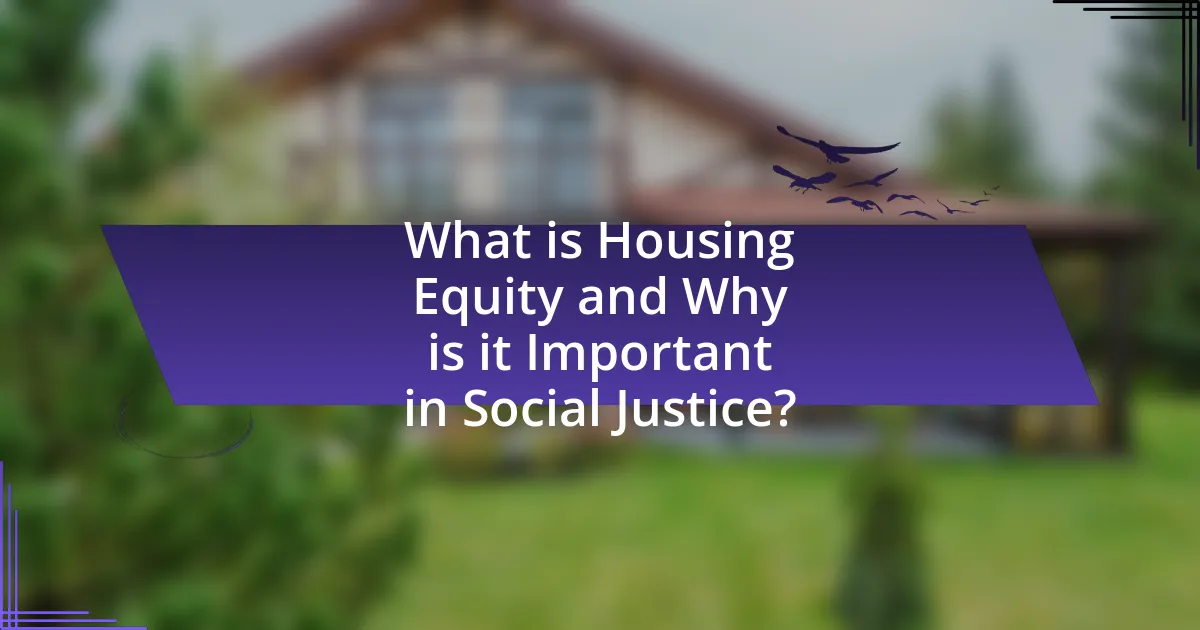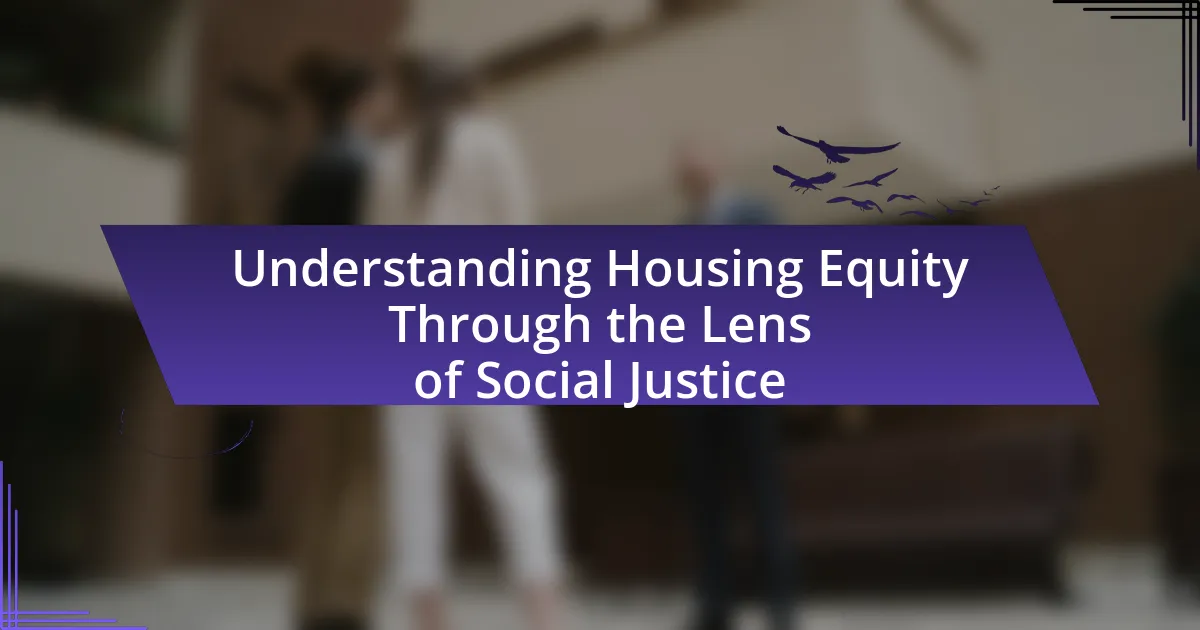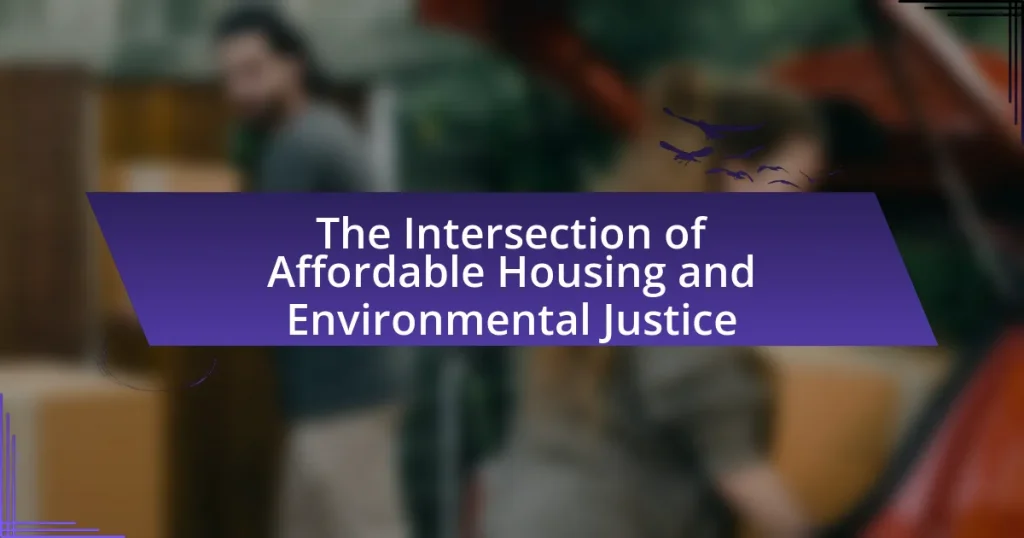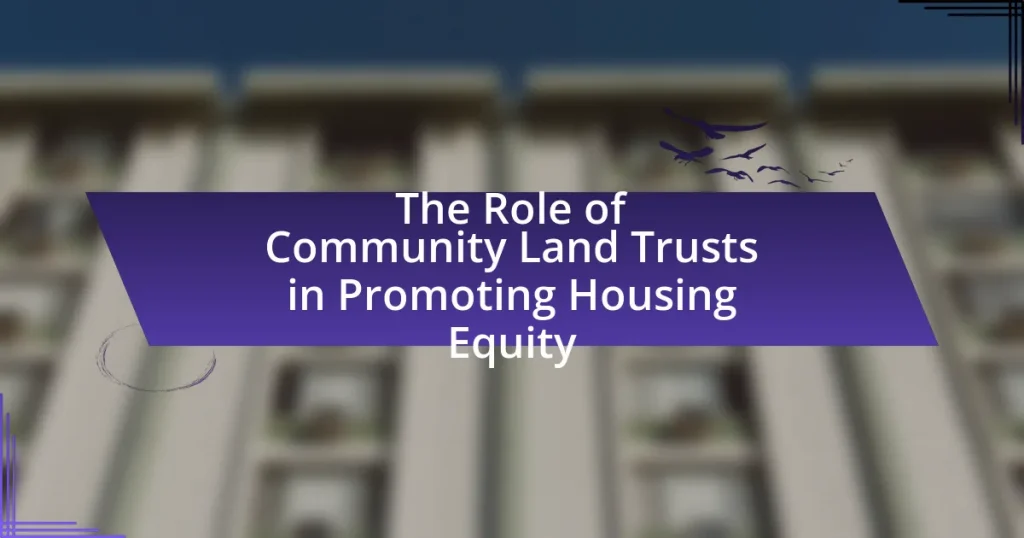Housing equity is defined as the fair distribution of housing resources and opportunities, ensuring access to safe and affordable housing for all individuals, regardless of socioeconomic status, race, or background. This article explores the significance of housing equity within the framework of social justice, highlighting systemic inequalities that have historically marginalized certain groups. Key principles such as access, affordability, and inclusion are examined, along with the historical factors and policies that have shaped housing disparities. The article also addresses current challenges, the impact of systemic racism, and strategies to promote housing equity, including inclusive zoning laws and community advocacy efforts. Through a comprehensive analysis of metrics and initiatives, the article underscores the importance of addressing housing equity as a vital component of achieving social justice.

What is Housing Equity and Why is it Important in Social Justice?
Housing equity refers to the fair distribution of housing resources and opportunities, ensuring that all individuals, regardless of their socioeconomic status, race, or background, have access to safe and affordable housing. This concept is crucial in social justice because it addresses systemic inequalities that have historically marginalized certain groups, contributing to disparities in wealth, health, and overall quality of life. For instance, research from the National Low Income Housing Coalition indicates that low-income households often spend more than 30% of their income on housing, which exacerbates poverty and limits access to essential services. By promoting housing equity, society can work towards dismantling these barriers, fostering inclusive communities, and ensuring that everyone has the right to a stable and secure home.
How do we define housing equity in the context of social justice?
Housing equity in the context of social justice is defined as the fair distribution of housing resources and opportunities, ensuring that all individuals, regardless of their socioeconomic status, race, or background, have access to safe, affordable, and quality housing. This concept emphasizes the need to address systemic inequalities that have historically marginalized certain groups, such as racial minorities and low-income families, in housing markets. For instance, studies show that discriminatory practices, such as redlining, have contributed to significant disparities in homeownership rates and wealth accumulation among different demographic groups, highlighting the importance of policies aimed at promoting equitable access to housing.
What are the key principles that underpin housing equity?
The key principles that underpin housing equity include access, affordability, and inclusion. Access refers to the ability of individuals and families to obtain housing without discrimination based on race, income, or other factors. Affordability ensures that housing costs do not exceed a certain percentage of a household’s income, typically recommended to be no more than 30%. Inclusion emphasizes the importance of diverse communities where all individuals, regardless of socioeconomic status, can live and thrive. These principles are supported by various studies, such as the National Low Income Housing Coalition’s report, which highlights the critical need for affordable housing to combat inequality and promote social justice.
How does housing equity relate to broader social justice issues?
Housing equity is fundamentally linked to broader social justice issues as it directly impacts access to resources, opportunities, and quality of life for marginalized communities. When housing equity is lacking, systemic inequalities are perpetuated, leading to disparities in education, health, and economic stability. For instance, studies show that neighborhoods with high levels of housing inequity often experience lower educational outcomes and higher rates of poverty, which are critical indicators of social justice. Furthermore, the lack of affordable housing disproportionately affects racial and ethnic minorities, reinforcing cycles of disadvantage and limiting their ability to build wealth. This connection underscores the importance of addressing housing equity as a vital component of achieving social justice.
What historical factors have shaped housing equity?
Historical factors that have shaped housing equity include discriminatory policies such as redlining, segregation laws, and urban renewal initiatives. Redlining, established in the 1930s, systematically denied mortgage loans to residents in predominantly Black neighborhoods, leading to disinvestment and wealth disparities. Segregation laws enforced racial separation, limiting access to housing for minority groups and perpetuating inequality. Urban renewal projects in the mid-20th century often displaced low-income communities, further exacerbating housing inequities. These historical practices have had lasting impacts on wealth accumulation and access to quality housing for marginalized populations.
How have policies and practices contributed to housing disparities?
Policies and practices have significantly contributed to housing disparities by enforcing discriminatory zoning laws and redlining practices. Historical policies, such as the Federal Housing Administration’s redlining maps in the 1930s, systematically denied mortgage insurance to predominantly Black neighborhoods, leading to disinvestment and a lack of access to quality housing. Additionally, exclusionary zoning laws have perpetuated segregation by restricting affordable housing development in affluent areas, thereby limiting opportunities for marginalized communities. Studies indicate that these practices have resulted in long-term wealth gaps and unequal access to resources, further entrenching housing disparities across racial and socioeconomic lines.
What role has systemic racism played in housing equity?
Systemic racism has significantly contributed to housing inequity by enforcing discriminatory practices that limit access to housing for marginalized communities. Historical policies, such as redlining, explicitly denied mortgage loans to residents in predominantly Black neighborhoods, leading to long-term disinvestment and wealth disparities. According to a 2020 report by the National Community Reinvestment Coalition, neighborhoods that were redlined in the 1930s continue to experience lower property values and higher poverty rates today, illustrating the lasting impact of these racist policies on housing equity.
What are the current challenges to achieving housing equity?
Current challenges to achieving housing equity include systemic discrimination, rising housing costs, and inadequate policy frameworks. Systemic discrimination manifests through practices such as redlining and discriminatory lending, which disproportionately affect marginalized communities. Rising housing costs, driven by factors like gentrification and limited affordable housing supply, further exacerbate inequities, making it difficult for low-income families to secure stable housing. Additionally, inadequate policy frameworks often fail to address these issues comprehensively, leading to a lack of effective solutions. According to the National Low Income Housing Coalition, there is a shortage of 7 million affordable rental homes for extremely low-income renters, highlighting the urgent need for targeted interventions to promote housing equity.
How do economic factors impact housing equity?
Economic factors significantly impact housing equity by influencing property values, access to financing, and overall market stability. For instance, rising income levels can increase demand for housing, leading to higher property values and potentially widening the equity gap between homeowners and renters. Additionally, economic downturns can result in job losses, reducing individuals’ ability to afford homes and leading to increased foreclosures, which further diminishes housing equity. According to the Federal Reserve, during the 2008 financial crisis, home equity for many households plummeted, highlighting how economic instability directly affects housing equity.
What barriers do marginalized communities face in accessing equitable housing?
Marginalized communities face significant barriers in accessing equitable housing, primarily due to systemic discrimination, economic inequality, and lack of access to resources. Systemic discrimination manifests through practices such as redlining, which historically denied mortgage loans to residents in predominantly Black neighborhoods, leading to long-term disinvestment and reduced property values. Economic inequality is evident in the wage gap, where marginalized groups often earn less than their white counterparts, limiting their ability to afford housing. Additionally, lack of access to resources, including credit and information about housing opportunities, further exacerbates these challenges. According to the National Low Income Housing Coalition, in 2021, there was a shortage of 7 million affordable rental homes for extremely low-income renters, highlighting the critical housing crisis faced by marginalized communities.

How is Housing Equity Measured and Evaluated?
Housing equity is measured and evaluated through various quantitative and qualitative metrics, including homeownership rates, property values, and access to affordable housing. These metrics assess disparities in housing opportunities among different demographic groups, often highlighting inequalities based on race, income, and geographic location. For instance, the U.S. Census Bureau provides data on homeownership rates, which can reveal significant gaps between racial and ethnic groups, indicating systemic barriers to equity. Additionally, tools like the Housing Equity Index, developed by organizations such as the Urban Institute, combine multiple indicators to evaluate housing equity comprehensively, considering factors like neighborhood stability and access to resources.
What metrics are used to assess housing equity?
Metrics used to assess housing equity include the Gini coefficient, homeownership rates, housing cost burden, and access to quality housing. The Gini coefficient measures income inequality within a population, which can correlate with housing disparities. Homeownership rates indicate the percentage of individuals or families that own their homes, reflecting economic stability and access to housing. Housing cost burden assesses the proportion of income spent on housing, with a burden defined as spending more than 30% of income on housing costs. Access to quality housing evaluates the availability of safe, affordable, and well-located housing options, often analyzed through geographic information systems (GIS) to identify disparities in different neighborhoods. These metrics collectively provide a comprehensive view of housing equity and highlight areas needing improvement.
How do we analyze data related to housing access and affordability?
To analyze data related to housing access and affordability, researchers employ quantitative methods such as statistical analysis and qualitative approaches like surveys and interviews. Quantitative data often includes metrics like median housing costs, income levels, and demographic information, which can be analyzed using software tools to identify trends and disparities. For instance, the U.S. Census Bureau provides data on housing costs and income, allowing for the calculation of affordability ratios, which indicate the percentage of income spent on housing. Qualitative data, gathered through community surveys, can reveal personal experiences and barriers faced by individuals in accessing affordable housing, providing context to the numerical data. This combination of methods enables a comprehensive understanding of housing equity issues, highlighting areas where intervention is needed to promote social justice.
What role do community surveys play in measuring housing equity?
Community surveys play a critical role in measuring housing equity by collecting data directly from residents about their housing experiences and needs. These surveys provide insights into disparities in access to affordable housing, quality of living conditions, and neighborhood resources, which are essential for understanding the extent of housing inequity. For instance, a study by the Urban Institute found that community surveys can reveal significant gaps in housing satisfaction and access among different demographic groups, highlighting areas where policy interventions are necessary to promote equity. By capturing the voices of diverse community members, these surveys inform policymakers and stakeholders about the specific challenges faced by marginalized populations, thereby guiding efforts to address systemic inequalities in housing.
How can we evaluate the effectiveness of housing equity initiatives?
To evaluate the effectiveness of housing equity initiatives, one can analyze key performance indicators such as changes in affordable housing availability, demographic shifts in housing access, and improvements in community health outcomes. These indicators provide measurable data that reflect the impact of initiatives on targeted populations. For instance, a study by the Urban Institute found that cities implementing inclusionary zoning policies saw a 15% increase in affordable housing units, demonstrating a direct correlation between policy implementation and housing equity. Additionally, surveys measuring resident satisfaction and community engagement can further assess the qualitative impact of these initiatives, providing a comprehensive evaluation framework.
What indicators show progress towards housing equity?
Indicators that show progress towards housing equity include the reduction of racial and ethnic disparities in homeownership rates, increased access to affordable housing, and improvements in housing quality for marginalized communities. For instance, the U.S. Census Bureau reported that the homeownership rate for Black Americans rose from 44.1% in 2019 to 45.4% in 2021, indicating a positive trend towards closing the racial gap. Additionally, the National Low Income Housing Coalition highlights that the number of affordable rental units has increased in several urban areas, reflecting enhanced access for low-income families. Furthermore, studies from the Urban Institute demonstrate that investments in community development and housing assistance programs have led to measurable improvements in housing conditions for historically underserved populations.
How do we assess the impact of policy changes on housing equity?
To assess the impact of policy changes on housing equity, researchers analyze quantitative data, such as housing prices, demographic shifts, and access to resources, alongside qualitative assessments from community feedback. This dual approach allows for a comprehensive understanding of how policies affect different populations. For instance, studies have shown that policies aimed at increasing affordable housing can lead to improved access for low-income families, as evidenced by a 2019 report from the Urban Institute, which found that cities implementing inclusionary zoning saw a 15% increase in affordable units. By combining statistical analysis with community insights, stakeholders can effectively evaluate the implications of policy changes on housing equity.

What Strategies Can Promote Housing Equity?
Strategies that can promote housing equity include implementing inclusive zoning policies, increasing affordable housing development, and providing financial assistance for low-income families. Inclusive zoning policies allow for a mix of housing types and prices within neighborhoods, which can reduce segregation and promote diversity. Increasing the development of affordable housing units addresses the supply-demand imbalance, making housing accessible to more individuals. Financial assistance programs, such as down payment assistance or rental subsidies, directly support low-income families in securing stable housing. According to the National Low Income Housing Coalition, there is a shortage of 7 million affordable rental homes for extremely low-income renters, highlighting the urgent need for these strategies to ensure equitable access to housing.
What policies can be implemented to enhance housing equity?
Policies that can be implemented to enhance housing equity include inclusionary zoning, affordable housing development incentives, and tenant protection laws. Inclusionary zoning mandates that a percentage of new housing developments be affordable for low- to moderate-income households, which directly increases access to housing for marginalized communities. Affordable housing development incentives, such as tax credits and grants, encourage developers to build more affordable units, addressing the supply shortage. Tenant protection laws, including rent control and anti-discrimination measures, safeguard vulnerable populations from displacement and ensure fair treatment in the housing market. These policies are supported by research indicating that equitable housing access leads to improved economic and social outcomes for disadvantaged groups.
How do inclusionary zoning laws contribute to housing equity?
Inclusionary zoning laws contribute to housing equity by mandating that a percentage of new residential developments be affordable for low- and moderate-income households. This approach directly addresses the disparity in housing access by ensuring that diverse income groups can live in the same neighborhoods, thereby promoting socioeconomic integration. For instance, cities like San Francisco and New York have implemented such laws, resulting in thousands of affordable units being created, which helps to mitigate the effects of gentrification and displacement. Studies indicate that these laws can significantly increase the availability of affordable housing, thereby enhancing overall community stability and equity.
What role do rent control measures play in promoting equity?
Rent control measures play a significant role in promoting equity by stabilizing housing costs for low- and moderate-income families. These measures limit the amount landlords can increase rent, which helps prevent displacement and allows residents to remain in their communities. For instance, a study by the National Bureau of Economic Research found that cities with rent control have lower rates of homelessness and greater housing stability among low-income residents. This stability contributes to social equity by ensuring that vulnerable populations have access to affordable housing, thereby reducing economic disparities and fostering diverse communities.
How can community organizations support housing equity?
Community organizations can support housing equity by advocating for policies that promote affordable housing and equitable access to resources. These organizations often engage in grassroots mobilization, educating community members about their rights and available housing options. For instance, studies show that community-led initiatives can lead to the development of affordable housing projects, as seen in the success of the Community Land Trust model, which has preserved over 15,000 affordable homes in the United States. Additionally, community organizations can provide legal assistance to combat housing discrimination, ensuring compliance with fair housing laws. By fostering partnerships with local governments and other stakeholders, these organizations can influence zoning laws and funding allocations, further advancing housing equity.
What initiatives have proven successful in advocating for housing rights?
Successful initiatives advocating for housing rights include the establishment of rent control laws, community land trusts, and legal aid programs for tenants. Rent control laws have been effective in stabilizing housing costs and preventing displacement, as evidenced by cities like New York and San Francisco, where such regulations have helped maintain affordable housing options. Community land trusts, which remove land from the speculative market, have successfully provided long-term affordable housing in various regions, including Burlington, Vermont, where the model has preserved housing affordability for decades. Legal aid programs, such as those offered by the Legal Services Corporation, have provided essential support to low-income tenants facing eviction, resulting in a significant reduction in eviction rates in areas where these services are available.
How can grassroots movements influence housing policy?
Grassroots movements can influence housing policy by mobilizing community members to advocate for equitable housing practices and policies. These movements often raise awareness about housing injustices, organize protests, and engage in lobbying efforts to pressure local governments and policymakers. For example, the 2019 “Housing Justice for All” campaign in New York successfully pushed for rent regulation reforms, demonstrating how collective action can lead to significant policy changes. Additionally, grassroots organizations often gather data and testimonies from affected residents, providing compelling evidence that can sway public opinion and legislative decisions.
What practical steps can individuals take to support housing equity?
Individuals can support housing equity by advocating for policies that promote affordable housing and equitable zoning laws. Engaging in local government meetings allows individuals to voice support for initiatives that address housing disparities. Additionally, volunteering with organizations focused on housing assistance can directly impact communities in need. Supporting local businesses in underserved areas fosters economic growth, which can lead to improved housing conditions. Furthermore, educating oneself and others about housing issues raises awareness and encourages collective action towards equitable solutions. Research indicates that community engagement and advocacy can significantly influence housing policy outcomes, as seen in successful campaigns for affordable housing in various cities.
How can community members engage in local housing advocacy?
Community members can engage in local housing advocacy by participating in local government meetings, joining housing advocacy organizations, and organizing community forums to discuss housing issues. These actions allow individuals to voice their concerns, influence policy decisions, and collaborate with others who share similar goals. For instance, attending city council meetings provides a platform for residents to express their views on housing policies, while joining organizations like the National Low Income Housing Coalition can amplify their efforts through collective action. Research shows that community engagement in housing advocacy leads to more equitable housing policies and improved outcomes for marginalized populations.
What resources are available for those seeking to understand housing equity better?
Resources available for those seeking to understand housing equity better include academic journals, government reports, and nonprofit organizations focused on housing issues. Academic journals such as the “Journal of Urban Affairs” and “Housing Policy Debate” provide peer-reviewed articles that analyze housing equity from various perspectives. Government reports, like those from the U.S. Department of Housing and Urban Development, offer data and policy analysis on housing disparities. Nonprofit organizations, such as the National Low Income Housing Coalition and the Urban Institute, publish research and advocacy materials that highlight the challenges and solutions related to housing equity. These resources collectively provide a comprehensive understanding of the complexities surrounding housing equity.



